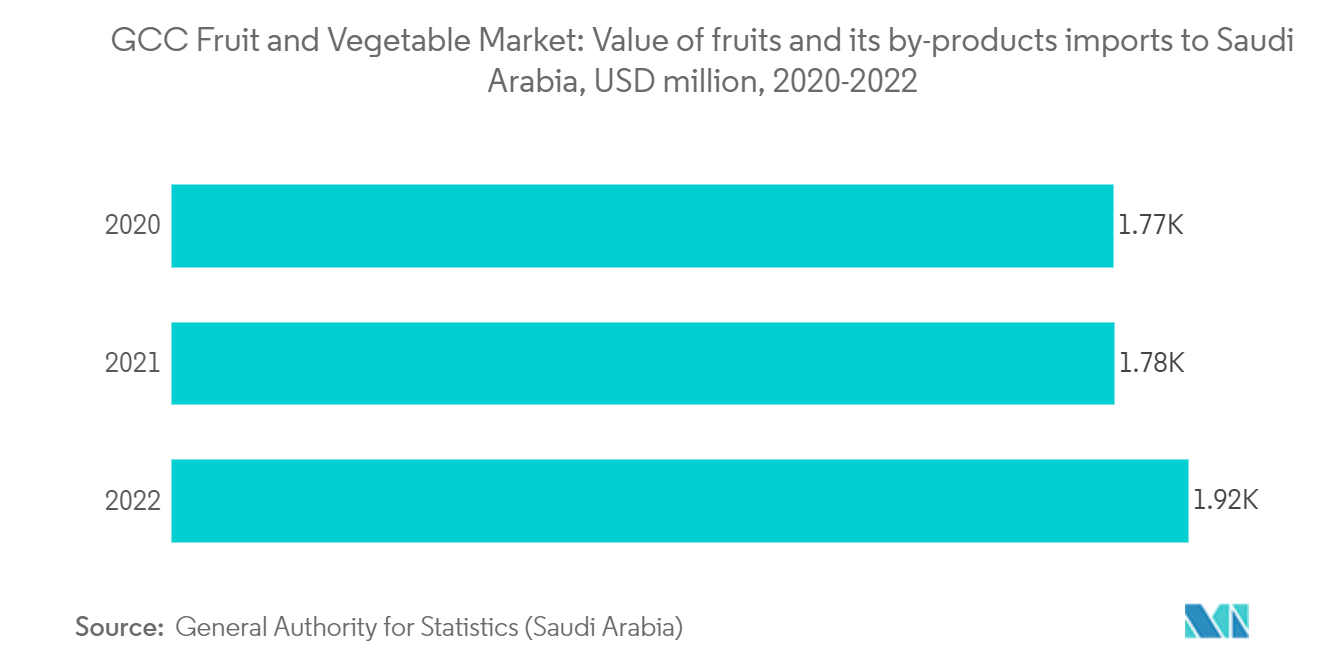Market Trends of GCC Fruits And Vegetables Industry
Increasing Adoption of Technology in Horticulture
Six countries in the GCC depend on imports (85%) to meet their food demand. This dependence on imports causes countries to be affected by supply chain bottlenecks. The GCC countries' population is anticipated to reach 58.3 million by 2030 and 72.3 million by 2050, highlighting the importance of new farming methods to feed the population without limitations. Moreover, the agricultural sector in the GCC countries encounters distinct difficulties because of dry climates and scarce natural resources. Therefore, innovative methods like hydroponics, vertical farming, and controlled-environment farming are increasingly used to efficiently utilize resources, lower water usage, and increase crop production. These methods allow farmers to improve crop yields and reduce losses from environmental factors by utilizing advanced irrigation systems, precision agriculture tools, and genetic modifications. For instance, in 2022, the Institute of Urban Agriculture (IUA) of the Chinese Academy of Agricultural Sciences (CAAS) enhanced vegetable production in Qatar by implementing a new method that combines hydroponics and solid active fiber soil, known as the Leitu technique. This technique uses an ecological material made from straw, cotton stalks, and other agricultural and forestry waste instead of soil. The Leitu technique allows for cultivating a comprehensive range of vegetables, such as leafy greens, eggplants, tomatoes, and cucumbers.
Due to increased awareness among GCC decision-makers about the necessity of a local food supply, significant investments are now directed toward hydroponic farming. In 2023, the National Bank of Bahrain provided financial assistance of USD 8.75 million to Al Amin Gardens for building Bahrain's first hydroponic farm.

Saudi Arabia is the Biggest Consumer of Fruits and Vegetables
The increasing health awareness among consumers, especially millennials, has driven the demand for fresh produce, such as fruits. Fruits are highly nutritious and loaded with vitamins C and A, nutrients, minerals, and other necessary antioxidants, so their demand has increased among consumers over the last few years. The country largely depends on imports to meet its fruit consumption needs.
People in Saudi Arabia have developed a preference for different types of grapes. There is a higher demand for varieties, such as red grapes, with large seeded sweet-tasting berries. Grapes yield large amounts of juice and take many forms in the food processing industry. Fresh grapes are usually popular among Arabs to be eaten raw in the fall and sometimes throughout the year. They are frequently served as a dessert, often with cheese, creating an exquisite combination. Moscatel grapes are served with foie gras, a specialty food made from the liver of a duck or goose. Grapes can also be combined with other fruits to create an exquisite Macedonian dish. While nearly half of all grapes are used to make wine, one-third is consumed as fresh fruit, and the remainder is dried, consumed as grape juice, or stored as grape musts (concentrated and non-concentrated).


